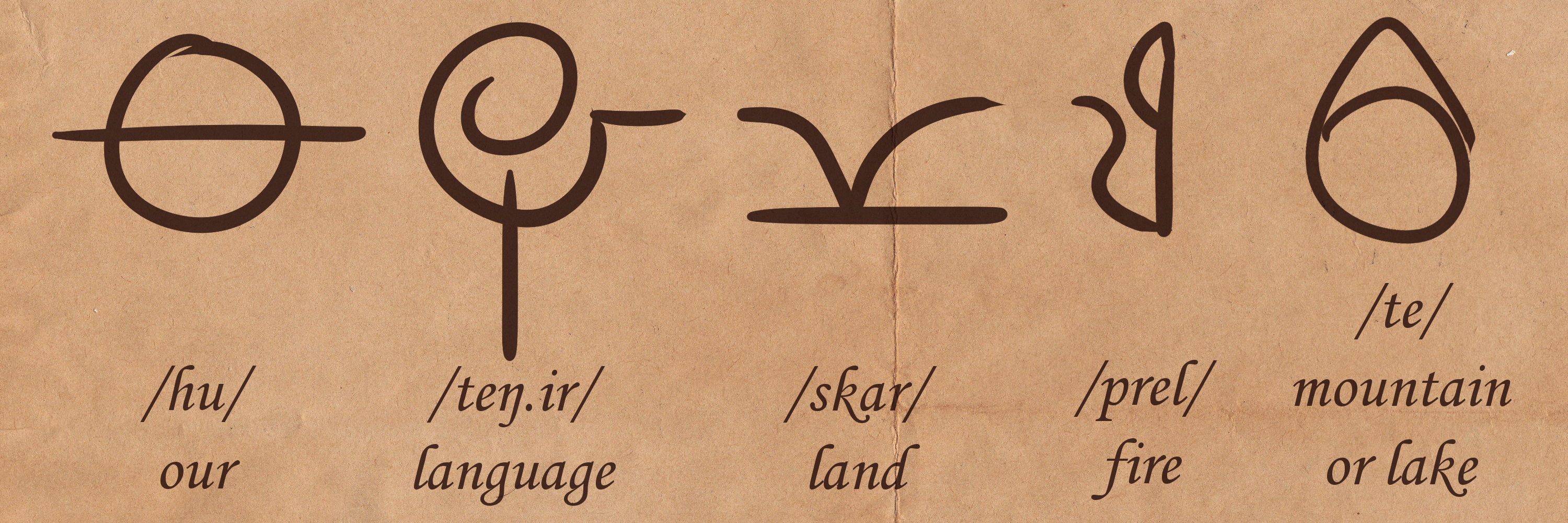Tengirhu
After helping the Yulemto revive their language, I'm ashamed to say I don't feel joy. All I feel is loss, for our own language is long dead, and it will not come back in my lifetime. It may never come back at all.Tengirhu, known most commonly as Skarhan, is an extinct group of closely related languages that were spoken in western Abravost. Once the native language of the Skarhan people, it ceased to be spoken nearly 700 years ago as a result of The Vosti Empire's conquest of the area and the introduction of the Vostan language.
History
Evidence of proto-Tengirhu being used in western Abravost date back many thousands of years, with the earliest sources being found in ruins in the north-west. This language soon spread from the north west to be spoken throughout the region, following the foothills of the Yesahli Mountains and the flowing of the River Lahda. It is believed to have split into at least three 'variants' based on geographic boundaries, these being the northern, southern, and western dialects. These were largely mutually intelligible, but had differences in vocabulary and some pronunciation. When the Vosti Empire came into the area around 570 BC, they initially made contact with speakers of the southern dialect. Throughout their gradual expansion and conquest further north and west, they interpreted all Tengirhu speakers as having the same 'gibberish' tongue, and the emperors rarely put any effort into learning the language so as to communicate with their new vassals. This ignorance of the local languages was pervasive throughout the Vosti settlers, and many forced their new neighbours to speak in Vostan so as to communicate. The introduction of Vostan marked the beginning of Tengirhu's decline as a commonly spoken language, though it persisted with some strength in rural and island communities. The death blow for the "Skarhan" languages came in the wake of the War of Vosti Succession, which had consumed the Empire for some 70 years. During these squabbles, many communities in the west had begun trying to claim independence from the empire and reassert their local culture. Once the war ended, Empress Askila I swiftly turned on her eyes to the region and worked to crush all such revolts and "eliminate separatist sentiment". To this end, she implemented vast education reforms to enforce the teaching of Vostan to the exclusion of Tengirhu. While the final native speaker of Tengirhu is not known, one of the last was a nobleman's servant by the name of Riha Vrenprela, who was punished for speaking the language in the presence of her employer in 226 BC. The languages went extinct sometime shortly thereafter, with very few texts or transcriptions accessible to the Skarhan people. This was the state of the languages for hundreds of years, up until the later 300s AC. After much work had been put into the revitalisation of the Yulemtan language, some Skarhan scholars turned their attention to the remnants of Tengirhu. In particular, Kion Uloedan spent many years cataloguing all known Tengirhu words and writings which existed in Skarhu, such as in place and proper names. He and his team put great effort into figuring out the meanings of what words they had, based on folk etymologies and contemporaneous sources, and the decipherment of Tengirhu glyphs. A breakthrough in this research was the discovery of the so-called "Prelt Papers", a collection of books and other artifacts found in a ruined town on the island of Prelt. This added not only hundreds of glyphs to the known inventory, but also a rare few bilingual texts, which have allowed some rare symbols to be tentatively decoded. As of 425 AC, progress has been slow but diligent.Features
Due to the lack of modern speakers, and the difficulty in deciphering old texts, some facts about the Tengirhu languages are not known for certain. The most well known feature is an aspiration contrast for the sounds /p t k/, as this so bewildered contemporary Vosti sources that plenty of ink was spent attempting to explain the difference between words which sounded identical to them. The focus on aspiration has left other sounds of the language ill-described, such as a so-called "deep f/v" for which little documentation exists. Searches for these sounds have been complicated by the Tengirhu writing system and how it was transliterated into the Vostan alphabet. As best as scholars can tell, Tengirhu glyphs each represented a word or morpheme, rather than individual letters or sounds. With this complicating efforts to understand texts, the addition of the wildly incosistent transliteration of native words comes into play. According to Kion's list, some place names in the country have shared origins obfuscated by their spelling. The most well known example is the word 'Tovar', which has been found in the placenames Dovapa, Tofanin, and Ttovvarhu. While some of the differences between these names may come from the differences in Tengirhu dialects, others likely come from Vosti writers altering 'accurate' transliteration to look nicer. The only case this does not seem to have applied to is Ttovvarhu, whose spelling seems downright bizarre to Vostan speakers. This suggests it more accurately describes the original word, which may have been pronounced /tʰo.?ar/, with the value of 'vv' remaining unclear.Writing System
The writing system for Tengirhu bears no resemblance to any other script used in Abravost, as while Vostan and Yulemtan use alphabets, it appears to use something closer to a logography. In this system, each glyph stands for a word or part of a word. However, some glyphs are used in places where their meaning would not make sense, suggesting that the pronunciations are occasionally reused in words that sound the same. A very limited amount of glyphs have been decoded, due to this reuse and the limited amount of bilingual sources. These mostly relate to things like the name of the land, language, and of the island of Prelt, due to being based on sources found there. A curious feature of the glyphs is that they can be written so that they 'connect', so that a horizontal line runs through most of a word. This seems to be used as a way to denote sentences or phrases, such that each one is on a new line. It could also be a stylistic choice or regional distinction, as it is not seen universally in old texts.
Successor Languages
Dialects
Though Tengirhu is known to have a minimum of three 'dialects' owing to geographic and cultural differences in western Abravost, the features which distinguished these languages from each other are not known with certainty. Many theories abound, with the most popular being proposed by Kion Uloedan.Northern
Kion's suggestion that Northern was the first language to evolve was not universally accepted until smaller archeological discoveries after his death. At minimum, it was the north which invented the Tengirhu writing system. It had a strong aspiration contrast and a frequent use of the "deep f/v", as evinced by place names like Ttovvarhu.Southern
Southern Tengirhu seems to have had the most distinct vocabulary, owing to sustained contact with Vostan speakers prior to the Vosti Conquest. Potentially as a consequence of this contact, the aspiration contrast was lessened, with aspirated consonants only appearing at the start of words.Western
Western Tengirhu maintains the aspiration contrast that Southern seemed to lack, with its uniqueness seeming to come from its vowels. Western words have been noted to lack word-final vowels, resulting in consonant clusters like the 'lt' in Prelt, which would not be allowed elsewhere in the language family.
Old Open Book by congerdesign
Remnants
Though Tengirhu is extinct, its existence can still be felt throughout Abravost's west. The most obvious way it persists is in place names, with the Republic of Skarhu taking its name from a word believed to mean "Our Land". It has also impacted the local variety of the Vostan language, known as Skarhan Vostan. In addition to small pieces of vocabulary and idioms translated directly, elements of aspiration and a distinctive syllable-final /h/ can be found through the dialect. The nearly 400 years of coexistence and bilingualism in Tengirhu and Vostan speaking communities also allowed for much cultural interaction. Southern speakers brought great amounts of theirs to their new Vosti overlords, such as their adoration for the river which ran through the land, and a focus on being self-reliant and sufficient. This remained part of the local culture even once the language died, and came in handy when The Collision left them adrift without imperial aid.
Burning Book by Movidagrafica





I so miss more info on the glyphs. The cover image looks pretty neat - I think it would make for a good writing script. With not so much hope that there are any native Tengirhu left, it still would be nice to trace any influence it had on other cultures. Do you think it influenced Vosti on the local level?